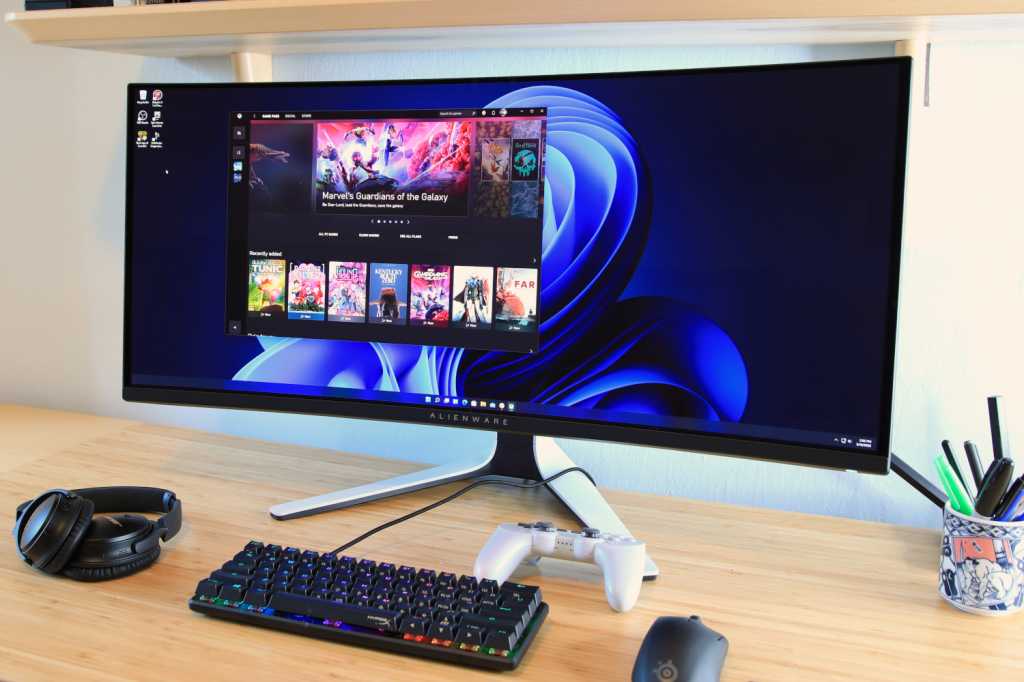Need a new monitor for your PC? We’ve combed through scores of options to find the best monitors on the market right now. Our picks are the result of hundreds of hours spent testing the latest models from Acer, Asus, BenQ, Dell, LG, Samsung, and other major brands.
While we feel that our favorite monitor overall is an awesome choice for most people, we also have alternative options for budget shoppers, gamers, and those seeking the best HDR performance. After all, not everyone needs the same features from a monitor. (If you’re looking specifically for a 4K monitor or gaming monitor, go check out our separate roundups highlighting your best options for those particular needs, as well.) You can find out more about how we evaluate monitors and what specs matter most below our list of recommendations.
Dell U3223QE – Best monitor overall
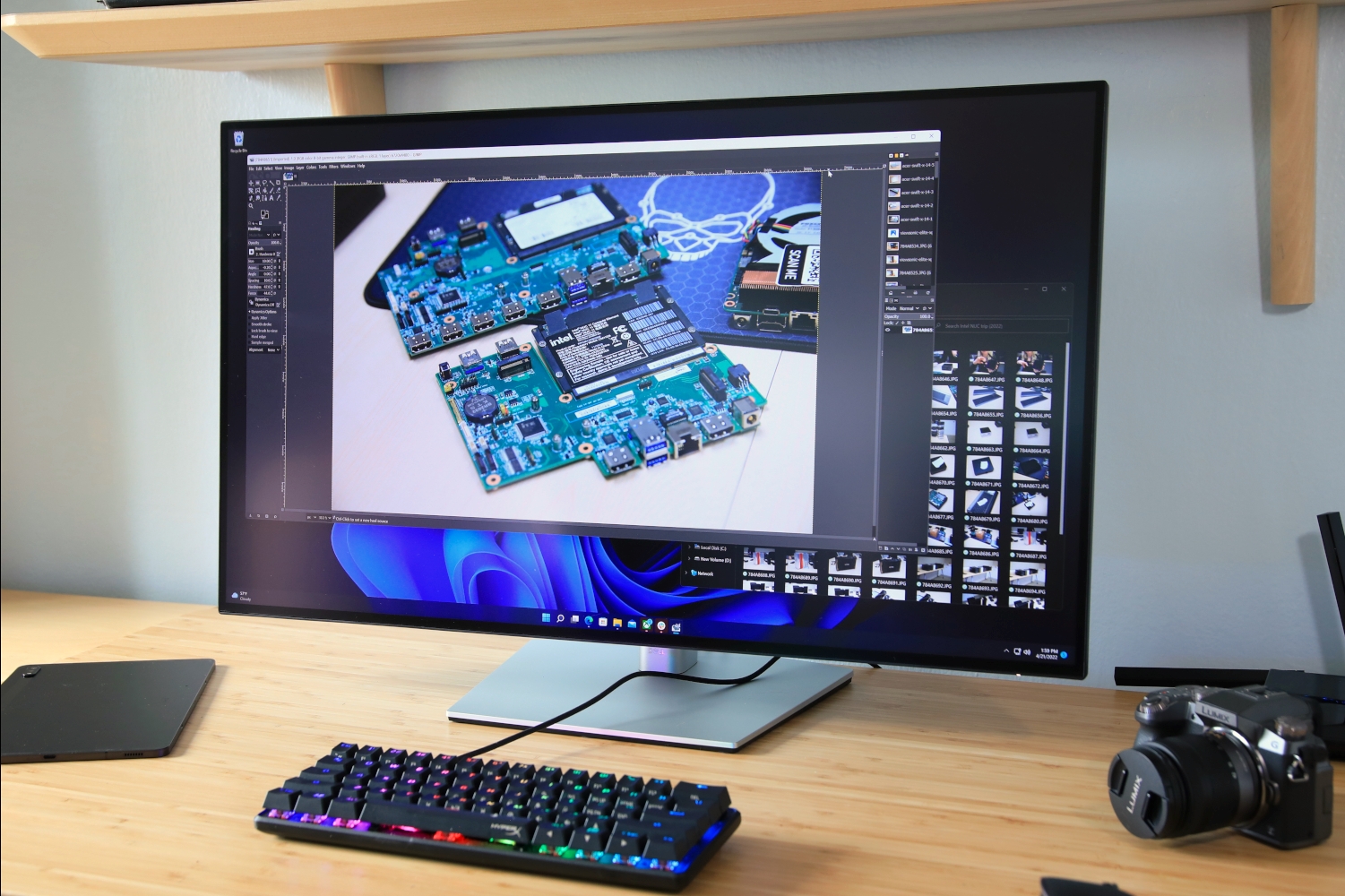
Pros
- IPS Black panel fulfills its promise
- Accurate color with wide gamut
- High brightness in SDR
- USB-C hub with 90 watts of power
Cons
- Edges of display are noticeably bright
- HDR performance disappoints
- Only a 60Hz panel
Dell’s U3223QE is a premium monitor with 4K resolution and gobs of connectivity.
The U3223QE has a cutting-edge IPS Black panel that roughly doubles the contrast when compared to other 32-inch IPS monitors. It provides a richer experience with a better sense of depth that’s especially noticeable when viewing in a dark room. The monitor also excels in color performance, brightness, and sharpness.
Connectivity is a highlight. This monitor offers USB-C with up to 90 watts of Power Delivery for charging a connected laptop or tablet. The USB-C port can drive a hub with a total of five additional USB-A ports, ethernet, and even DisplayPort-out (meaning you can daisy-chain video to a second monitor).
This monitor has a smaller sibling, the Dell U2723QE, which is less expensive. We did not receive it for testing but expect it to perform similarly, as it uses the same IPS Black panel technology.
Acer K242HYL – Best budget 1080p monitor

Pros
- Attractive color accuracy and gamut
- Acceptable sharpness for a 1080p display
- Avoids motion clarity pitfalls
- Menu system is easy to use
Cons
- Barebones design
- No height adjustment on stand
- Only one HDMI, no DisplayPort
- Power LED is very bright
Need a monitor that works well at an extremely low price? The Acer K242HYL is our go-to pick.
The Acer K242HYL’s specifications are good for a budget display. It has a 24-inch screen with 1080p resolution and a maximum refresh rate of 75Hz. Adaptive sync is supported, so the monitor will function with AMD FreeSync and Nvidia G-Sync. Video inputs include HDMI and VGA. Build quality is good thanks to robust plastic panels that feel thick and durable when handled.
This monitor has a bright image with reasonable contrast. Color performance stands out, as the monitor can cover most of the sRGB color gamut and has extremely good color accuracy overall. Photos, videos, and games look close to what their creator intended.
The K242HYL lacks a height-adjustable stand but offers a VESA mount that is compatible with most third-party monitor stands and arms.
That aside, the K242HYL is an outstanding budget monitor suited for everyday use, casual gaming, and amateur content creation. This is all the monitor most people will ever need.
Monoprice CrystalPro 44522 – Best budget 4K monitor
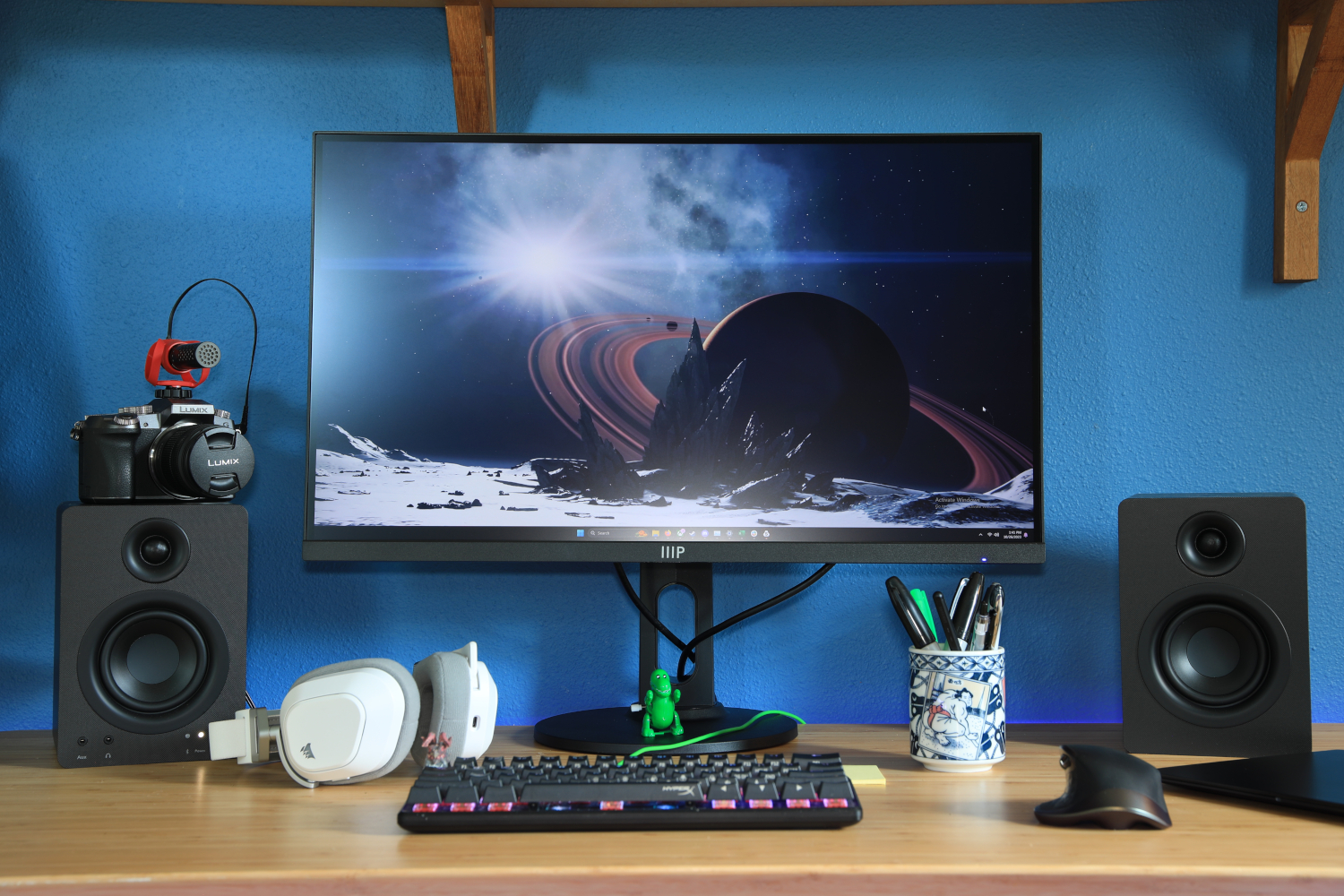
Pros
- Sharp, clear image
- Strong color performance
- Functional ergonomic stand
- Includes USB-C despite low price
Cons
- Generic design
- Limited image quality adjustments
- Not a great choice for viewing games and movies
The Monoprice CrystalPro (Model #44522) stands out as the best budget 4K monitor choice, offering a sharp and vibrant 4K display at an affordable price point of $300 (which is often reduced below $220 during sales).
Image quality is a highlight. The Monoprice CrystalPro delivers a crisp 27-inch IPS panel, a decent color gamut, and good color accuracy. The monitor’s contrast is mediocre but competitive with other budget 4K monitors.
Connectivity is surprisingly good. The monitor includes USB-C connectivity with support for up to 65 watts of USB Power Delivery, which makes it possible to charge a connected tablet or laptop. That feature is usually reserved for more expensive monitors. Monoprice also includes a decent ergonomic stand that can adjust for height, tilt, and swivel. Many similarly priced competitors only adjust for tilt.
The monitor has a couple downsides. Its design is generic and its limited image quality adjustments can make image quality more difficult to customize. These problems are usually shared by competitors, however, which leaves Monoprice in a good spot.
Shoppers should note our recommendation applies to the 27-inch CrystalPro monitor with model number 44522. Monoprice also has an older, 28-inch model that’s easy to confuse with this newer display. Our recommendation only applies to model 44522.
Innocn 27M2V – Best budget HDR monitor
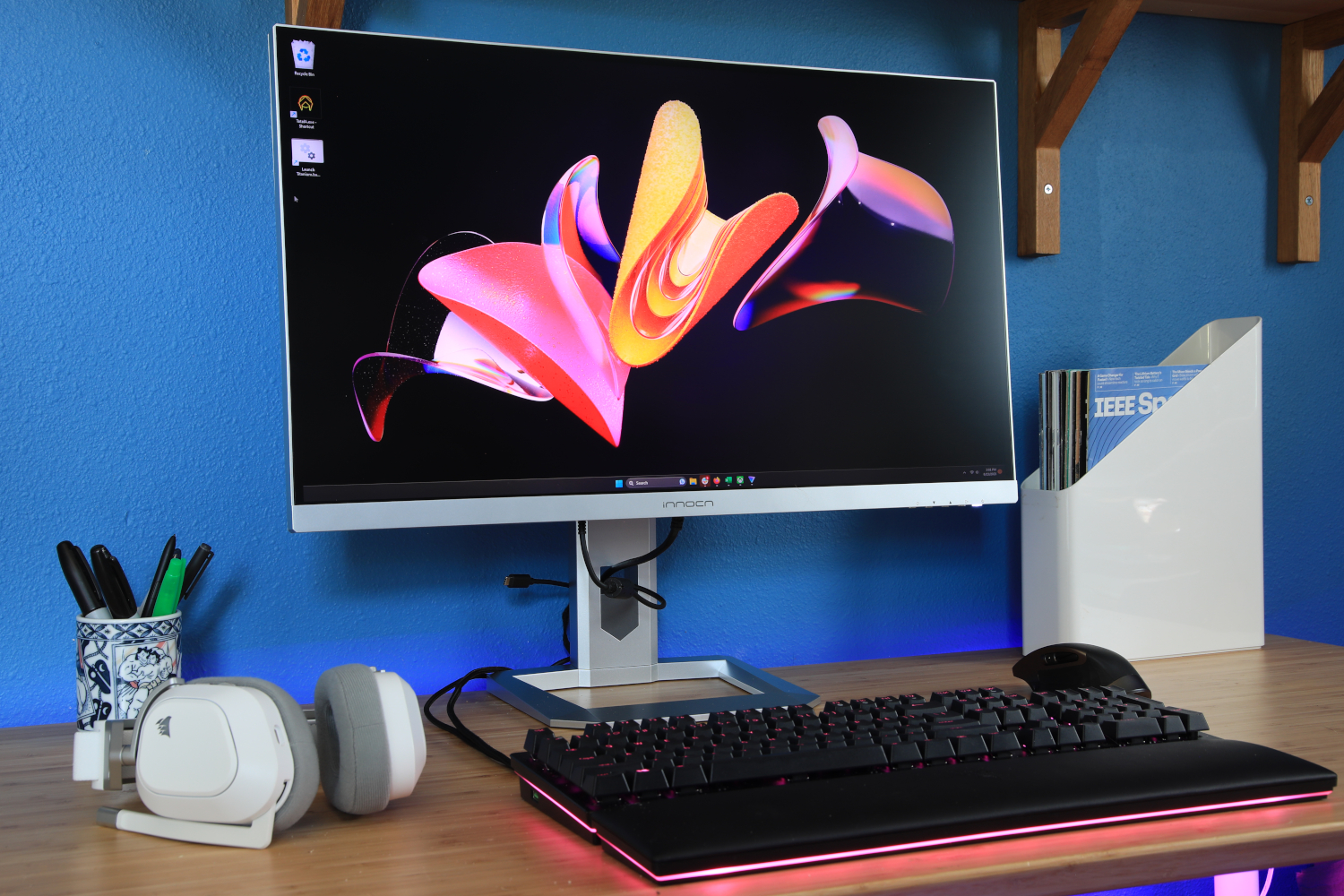
Pros
- Excellent color gamut and accuracy
- Sharp, vivid picture
- Strong HDR performance
- Good connectivity
Cons
- Design looks nice, but feels inexpensive
- Thin user manual
- Confusing on-screen menu
You likely haven’t heard of Innocn—but if you want a great HDR monitor on a slim budget, the Innocn 27M2V should be on your short list.
The Innocn 27M2V is a 4K Mini-LED monitor with a maximum refresh rate of 160Hz. It hits an impressive maximum measured HDR brightness of 877 nits, which is enough to deliver a gut-punch of detailed luminance in vibrant HDR scenes. The 27M2V outperforms OLED and LED edge-lit monitors.
And it’s no one-trick pony. The 27M2V has accurate and vivid color, immersive contrast, and crystal-clear sharpness. It can’t defeat OLED monitors like the Alienware AW3423DW in SDR content, but it’s closer than you’d think.
The 27M2V provides strong connectivity, too. It includes a USB-C port with 90 watts of Power Delivery for charging external devices. That’s flanked by one DisplayPort and two HDMI 2.0 ports, for a total of four video inputs.
What’s the catch? The monitor’s design, although reasonably attractive, feels inexpensive when handled. The on-screen menus are confusing, a problem worsened by the lack of a quality user manual. And customer support can only be reached by email.
Fortunately, these issues are reduced by excellent pricing. The Innocn 27M2V has a retail MSRP of $799.99 on Amazon, but frequently goes on sale for as little as $679.99. It’s fantastic value at either price.
Asus ROG Swift PG32UQX – Best HDR monitor

Pros
- Excellent gaming performance
- 4K resolution
- Dimmable mini-LED backlight
- Ergonomic adjustment options
Cons
- High power consumption
- Extremely expensive
Okay, folks. Hold onto your butts, because we’re about to take a trip out to the cutting-edge of PC monitors: the Asus ROG Swift PG32UQX.
This monitor has a Mini-LED backlight with 1,152 zones that can adjust brightness independently. As a result, it can ramp up brightness to extremely high levels when required, or turn off zones entirely in dark scenes. This results in an excellent contrast ratio and superb brightness.
These traits make the PG32UQX a standout in HDR games and movies. Bright, high-contrast scenes look amazing. You can almost feel the heat of an explosion and the intense glare of sun reflecting off a window or mirror.
There’s more to the monitor than HDR, however. It scores extremely well in overall contrast, has class-leading color performance, and provides a crisp 4K image. The monitor supports G-Sync Ultimate for smooth gameplay with Nvidia hardware and has a maximum refresh rate of 144Hz.
The only problem? Price. This monitor sells for around $3,000. Shoppers may want to consider the slightly less exorbitant Viewsonic Elite XG321UG as an alternative. It has a similar Mini-LED backlight.
Philips Creator Series 27E2F7901 – Best home office monitor
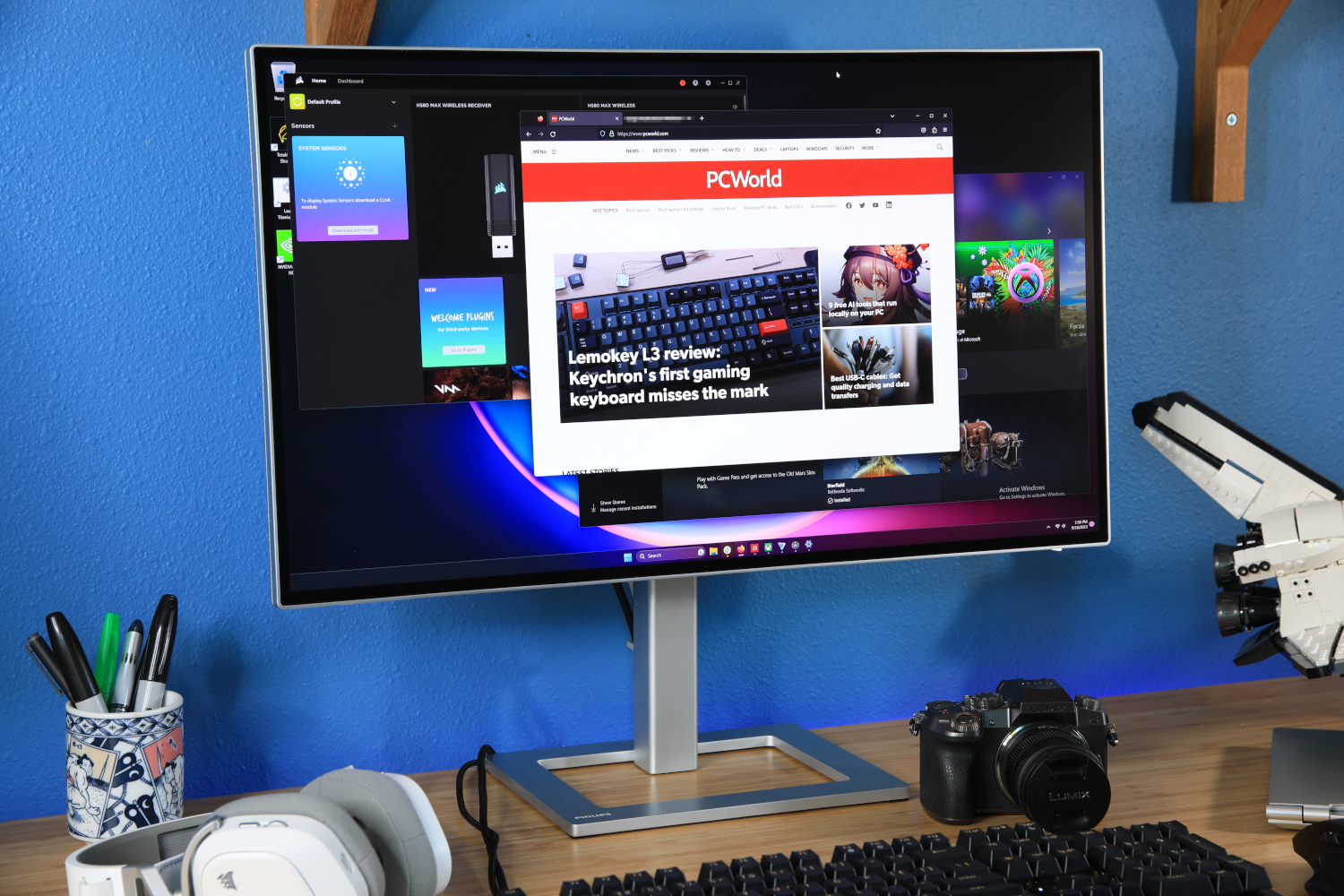
Pros
- IPS Black panel improves contrast ratio
- Excellent color gamut and accuracy
- Sharp 4K image
- USB-C connectivity with Power Delivery, DisplayPort-Out
Cons
- Generic design
- Awkward on-screen menu system
- Lackluster HDR, 60Hz refresh rate
Philips’ Creator Series 27E2F7901 is the ideal monitor for your home office. It features a 27-inch display with IPS Black panel technology, tons of useful connectivity, and top-notch image quality.
Its IPS Black display panel is a rather new technology that significantly enhances the contrast ratio compared to older IPS monitors, which results in a deeper, more immersive image. Its color gamut and accuracy are commendable, too, and its 4K resolution means web pages, photos, and PDFs all look razor-sharp.
Connectivity is another big strength. The 27E2F7901 accepts video over HDMI, DisplayPort, and USB-C, with the latter also serving as a USB hub for multiple downstream USB ports. The USB-C port is also capable of charging devices that require up to 96 watts of power. It has DisplayPort-Out, as well, an uncommon connection that can connect a second monitor directly to the Philips.
While the monitor’s design is not as attractive as Dell’s Ultrasharp series, it still retains the features most people need. It comes with an ergonomic stand that adjusts for height, tilt, swivel, and pivot. The monitor also has an adapter for use with 100x100mm VESA mounts, making third-party monitor arms and stands an option.
Though excellent, the 27E2F7901 isn’t perfect. The on-screen menu system can be awkward to navigate. Also, while HDR is supported, the monitor’s HDR performance is underwhelming. And its humble 60Hz refresh rate will disappoint gamers.
These downsides are not uncommon as many competitors also have them. Due to the Philip’s pricing however, these can be forgiven—the 27E2F7901 retails for just $499.99. Though not inexpensive, it undercuts similar home office monitors from Dell and LG by roughly $100. Overall it provides exemplary value by delivering top-tier connectivity and image quality for an excellent price.
Viewsonic ColorPro VP16 OLED – Best portable monitor
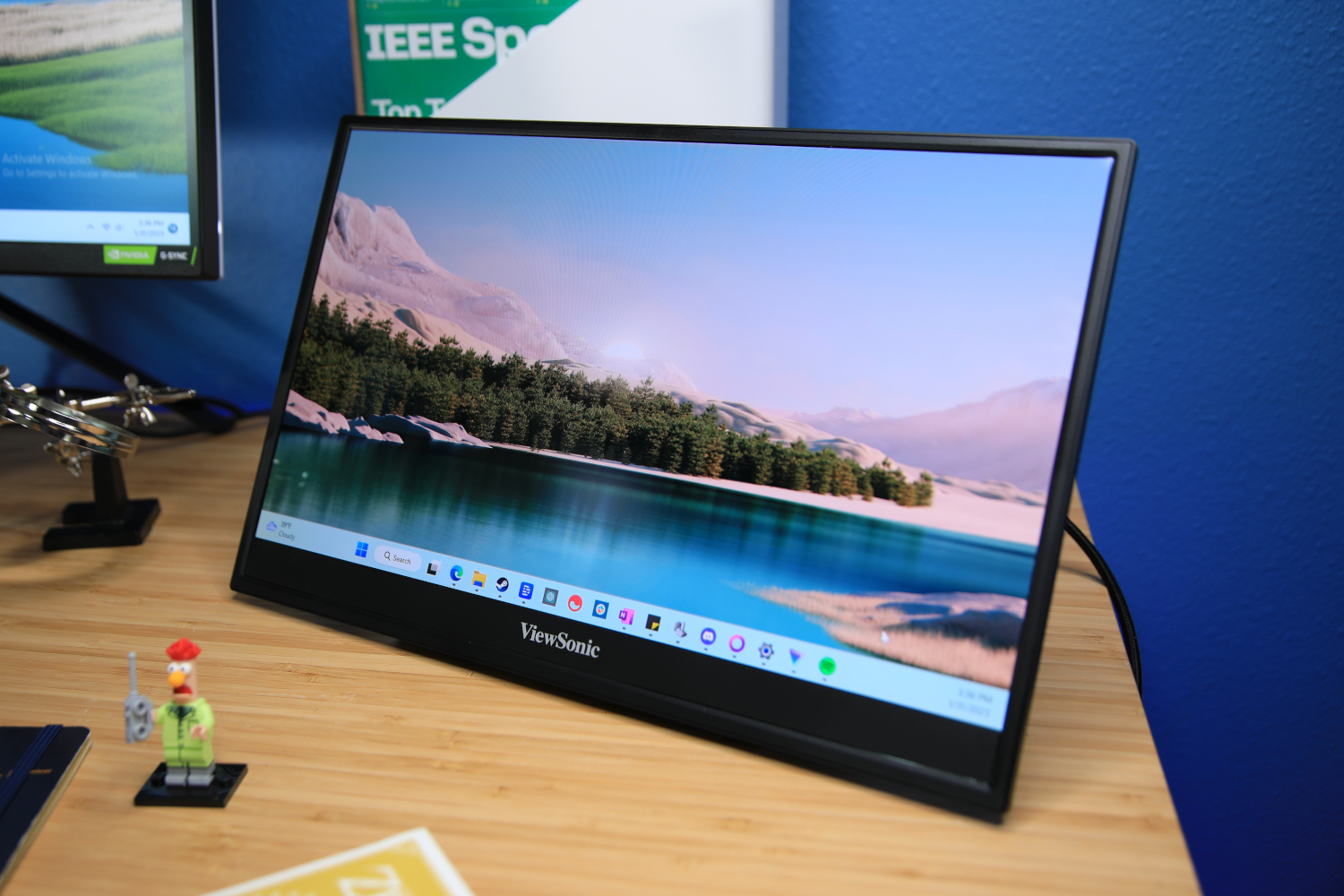
Pros
- Versatile, useful stands
- Good connectivity, cables included
- Numerous image quality customization options
- Top-tier image quality even at default settings
Cons
- Speakers are included, but weak
- Pricey for a portable monitor
- No HDR
The Viewsonic VP16-OLED is an impressive portable OLED monitor that combines class-leading image quality with a unique and useful stand.
As its name suggests, the VP16-OLED has a 15.6-inch OLED panel with 1080p resolution. It delivers outstanding image quality, scoring top marks in color accuracy, gamut, and contrast. The VP16-OLED’s performance is superior to many full-sized OLED monitors—and completely smashes portable competitors. This makes the VP16-OLED ideal for photographers, videographers, and other content creators.
The monitor has a versatile stand. It can be used as a kickstand, as is true of most portable monitors, or expand to hold the monitor upright. The stand includes two USB-C ports, either of which can be used to provide power and video input to the monitor. It also offers a micro-HDMI port for use with devices that lack USB-C. Viewsonic bundles the monitor with several cable types and a USB-C power brick, so you don’t have to buy additional adapter cables or accessories.
There’s just one problem: It’s expensive. The Viewsonic VP16-OLED retails at $399.99, more than double the price of a basic 1080p portable monitor. That’s tough to justify if you just need a second monitor to display Slack and Twitter, but it’s a worthwhile upgrade if you care about image quality.
Asus ProArt PA348CGV – Best ultrawide monitor
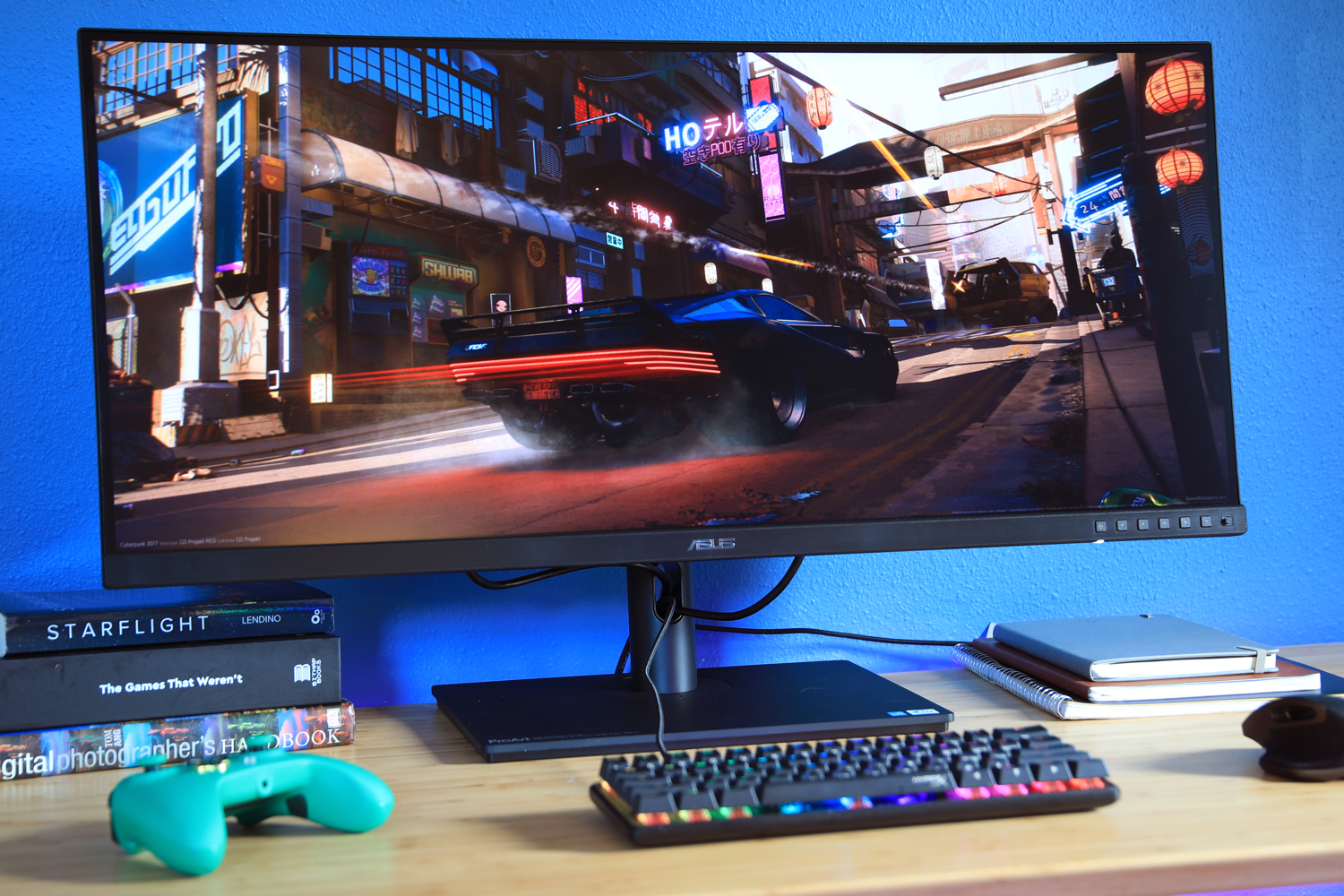
Pros
- Excellent SDR image quality
- Sturdy, hefty design
- Wide range of customization
- 120Hz refresh rate
Cons
- USB-C hub lacks video-out or ethernet
- HDR is merely passable
Asus’ ProArt PA348CGV is an ultrawide that targets professionals but throws in features to please gamers.
Professionals will love the PA348CGV for its excellent color accuracy, wide color gamut, and healthy range of image quality adjustments. The monitor looks outstanding at default settings and can be tuned to fit a variety of color gamuts or meet specific color temperature and gamma targets.
Monitors like this normally leave gamers in the cold, but the PA348CGV is an exception. It has a maximum refresh rate of 120Hz and supports AMD FreeSync Premium Pro. Its motion clarity can’t rival the best 144Hz or 165Hz ultrawide gaming monitors, but it’s a huge boost over a 60Hz panel.
The PA348CGV is built like a tank with sturdy plastics and a weighty stand that keeps the ultrawide panel planted. It also has good connectivity with a total of four video inputs, one of which is USB-C. The USB-C port drives a hub with four additional USB-A ports.
And here’s the real surprise: the PA348CGV’s MSRP is just $729. That’s not cheap, but it’s close to the price of alternative professional monitors that completely lack an enhanced refresh rate or adaptive sync. That makes the PA348CGV an easy choice for ultrawide enthusiasts.
Alienware AW3423DWF – Best gaming monitor
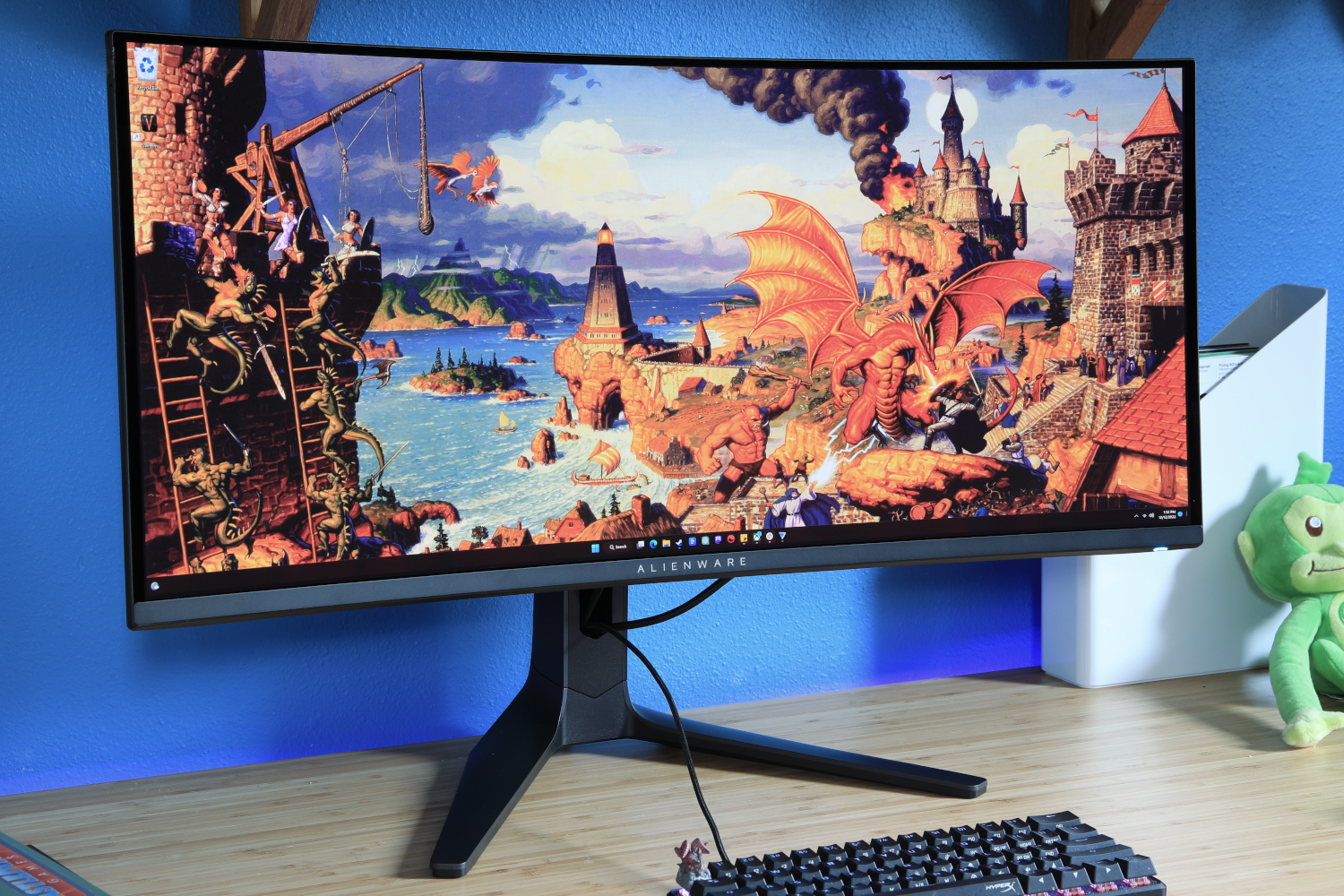
Pros
- Excellent contrast ratio
- Top-notch color gamut and accuracy
- Great motion clarity
- Respectable HDR performance
- Extremely competitive price
Cons
- Stand is a bit too large
- No USB-C
- Maximum HDR brightness is lackluster
Alienware’s AW3423DWF is an outstanding PC gaming monitor.
This monitor has a QD-OLED panel, which is like that used in top-tier OLED televisions. OLED provides a nearly infinite contrast ratio, excellent color performance, and respectable brightness. The result is a punchy, vibrant image with an unparalleled sense of dimensionality. The monitor’s ultrawide aspect ratio only heightens the sense of immersion.
Motion clarity is superb. The monitor has a refresh up to 165Hz and supports both AMD FreeSync Premium Pro and VESA Adaptive Sync. The OLED panel technology it uses has lower pixel response times than competitors, too, so there’s minimal added blur and ghosting in motion. Motion is as crisp as you’ll find below 240Hz.
The Alienware AW3423DWF is an alternative to the AW3423DW, a slightly older and nearly identical monitor. The AW3423DW has a higher fresh rate of 175Hz and supports Nvidia G-Sync Ultimate. It’s also $100 to $200 more expensive. Though we recommend the AW3423DWF for most people, the AW3423DW is better for owners of high-end Nvidia graphics cards.
The AW3423DWF is expensive at $1,099.99, but its performance justifies the price. Competing 34-inch and 38-inch ultrawides without QD-OLED technology are often just as expensive but have less impressive image quality.
Dell G2724D – Best budget gaming monitor

Pros
- Handsome design with functional stand
- Attractive SDR image quality
- Good motion clarity at 165Hz
- Supports all Adaptive Sync standards
Cons
- No USB connectivity or 3.5mm audio-out
- Lackluster HDR
Dell’s G2724D hits the sweet spot for gamers on a budget who also care deeply about quality.
The 27-inch IPS LCD panel features 1440p resolution and a refresh rate of 165Hz. The color gamut spans 100 percent of sRGB, 86 percent of DCI-P3, and 82 percent of Adobe RGB, ensuring a bright and vibrant image that’s not only excellent in games but serviceable for most content creation. But its standout feature is the Adaptive Sync support, with official support for VESA Adaptive Sync, AMD FreeSync Premium, and Nvidia G-Sync.
Despite its affordable price, the monitor doesn’t skimp on design, with a handsome matte black and gray chassis and sporty rear vents that provide an aggressive yet unobtrusive look. It also comes with a functional monitor stand that offers a range of ergonomic adjustments and a compact base that doesn’t take up unnecessary desktop space.
The monitor doesn’t offer USB connectivity or 3.5mm audio-out. Also, the HDR performance is a bit lackluster, so those who require HDR gaming may want to look at other options.
But it’s hard to beat the G2724D’s performance at $300 or below and, more importantly, it offers everything an average PC gamer is going to need for smooth and responsive gaming. All told, it offers excellent value, and could have a place on your desk for five to 10 years.
Alienware AW2524H – Best high-refresh monitor
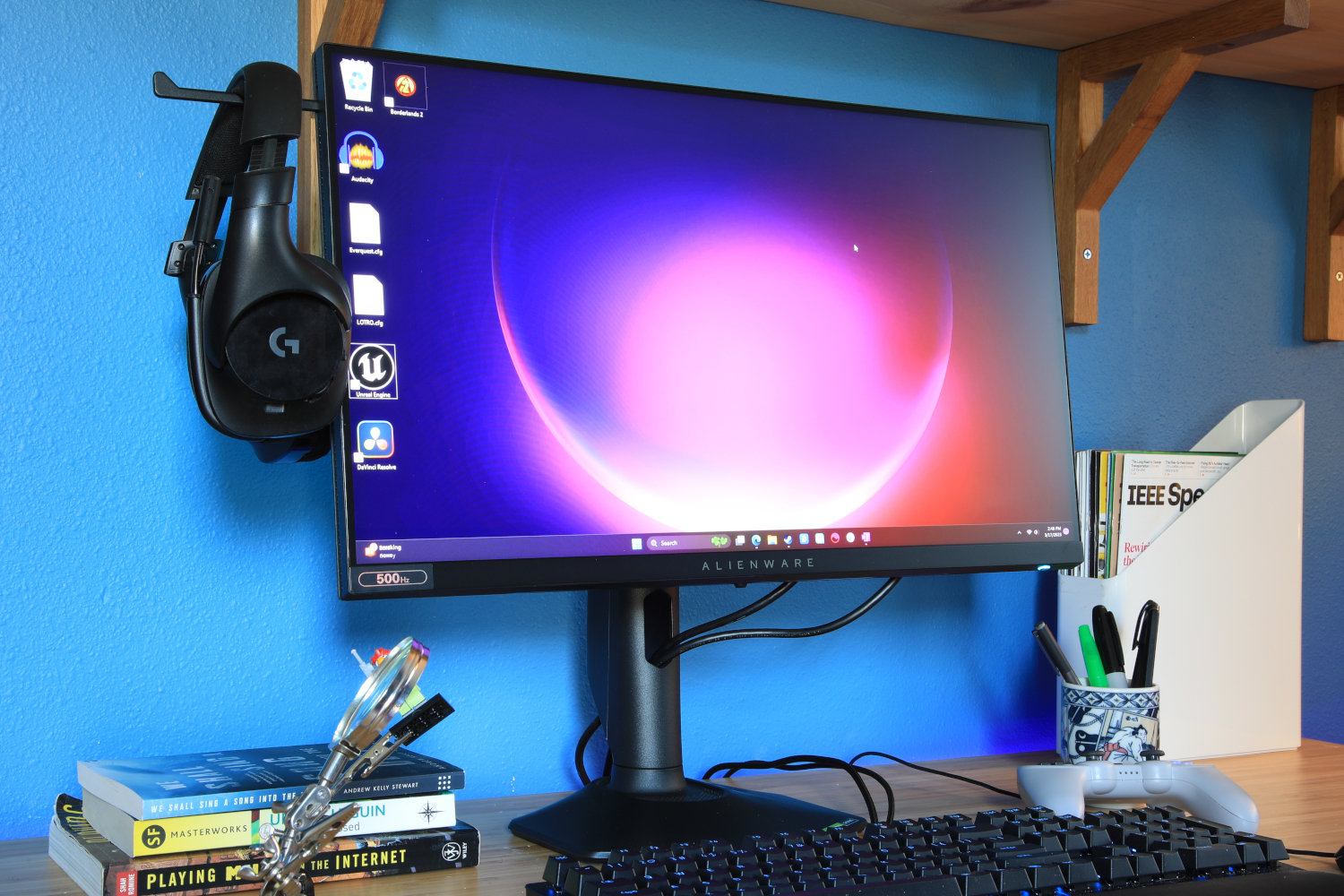
Pros
- The best motion clarity available today
- Bright, vivid image quality
- Compact ergonomic stand
Cons
- Limited video input selection
- Mediocre image quality
- High pricing for a 24-inch monitor
Do you want motion clarity? Alienware’s AW2524H, the world’s first 500Hz gaming monitor, is for you.
Fast objects look detailed and quick camera pans across an in-game map remain legible. Competitive gamers will also love its lightning-fast input latency with support for Nvidia Reflex Analyzer, which helps players see precisely how fast their PC responds to input. Just be warned: this performance comes at a premium price of $829.99 MSRP, and the benefits can only be fully realized in games that can reach 500 frames per second.
It’s an attractive monitor, too, with Alienware’s sleek, futuristic design and excellent build quality. The compact stand allows for ergonomic adjustment but doesn’t consume excessive desk space.
The AW2524H’s image quality is not competitive with similarly priced monitors, but it’s not bad, either. It offers strong SDR image quality with decent brightness, good contrast ratio, and vivid color. However, the HDR image quality is underwhelming, and the monitor lacks some connectivity options, such as USB-C input.
Alienware’s super-fast 500Hz monitor isn’t for everyone, but competitive gamers shouldn’t think twice. The monitor’s motion clarity is unbeatable.
Asus ProArt Display OLED PA32DC – Best monitor for professionals
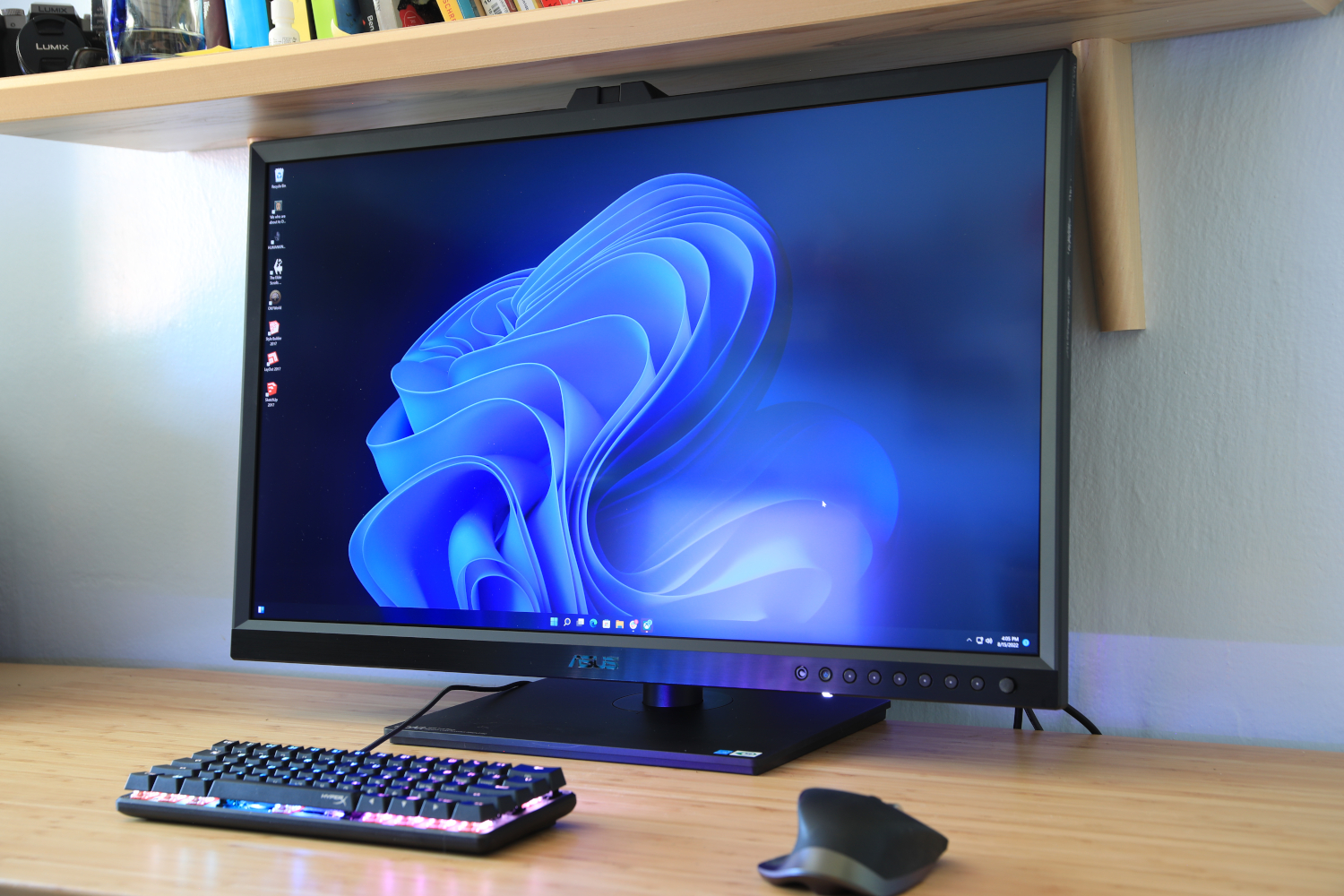
Pros
- The best SDR image quality yet
- Good HDR performance
- Long list of image quality features
- Exceptionally sturdy
- Numerous inputs, plus USB hub
Cons
- HDR brightness could be better
- Glare can be an issue in bright rooms
- Only 60Hz, no adaptive sync
Do you need a monitor with exceptional color accuracy, contrast, and sharpness? The Asus ProArt Display OLED PA32DC delivers. It’s an impressive monitor that, in several respects, is the best we’ve ever reviewed.
The monitor’s key trait is its high-quality OLED display panel. It has excellent contrast, color accuracy, and a wide color gamut, all of which add up to a realistic and dramatic image. The monitor also has 4K resolution and a conventional RGB subpixel layout, which avoids the color fringing issues that are found in QD-OLED monitors like the Alienware AW3423DW.
Image quality is superb out of the box, but experienced owners can go a step further. The PA32DC has numerous image quality options in its on-screen menu system and includes a built-in calibration utility for ultra-accurate results. Professionals can use these options to achieve the exact results their work requires.
It’s a wonderfully robust monitor with chunky bezels, big menu buttons, and a sturdy chassis that includes a built-in handle. Asus supplies both a VESA stand for desktop use and flip-out legs for quick setup at a mobile studio or job site. The monitor has extensive connectivity including five video inputs.
The only downside? It’s expensive with a retail price of $3,000. Even that, however, is not so bad: Similar OLED and Mini-LED monitors, like the Apple Pro Display XDR and LG UltraFine 32EP950, are often even more expensive.
Acer Predator CG48 – Best television alternative

Pros
- Excellent SDR, strong HDR image
- Great motion clarity
- Superior contrast and wide color gamut
- Multiple PC-friendly connections including USB-C hub
- Useful bundled remote
Cons
- Only one HDMI 2.1 input
- Sharpness is just ok
- Stand offers no adjustment, no VESA mount
Want a massive display, but don’t want to deal with the “smart” features and limited PC connectivity of a television? Acer’s Predator CG48 is an excellent choice.
This 48-inch OLED monitor delivers 4K resolution and a refresh rate up to 138Hz. It offers an outstanding picture straight out of the box with spot-on color accuracy, excellent contrast, and a wide color gamut. It also has excellent viewing angles and, of course, a large display area that’s ideal for a large office or small home entertainment center. The monitor’s maximum brightness could be higher, but it still looks good in HDR content, especially when used in a dark room.
Though similar in size to some OLED televisions, the Acer Predator CG48 is not a TV. It doesn’t have a TV tuner and can’t connect to a coaxial antenna or cable connection. PC connectivity is superb, though, with DisplayPort, USB-C, and HDMI 2.1 available, as well as three additional HDMI 2.0 ports.
A remote is included and can be used to navigate the monitor’s on-screen menu. Acer provides a wide range of image quality adjustments that make it easy to customize the image to your liking. The monitor’s out-of-box performance was excellent, too, and worked well with both PC and game console inputs.
The Acer Predator CG48 carries a MSRP of $1,499.99, which is high. It’s often on sale, so it’s wise to shop around. Buying the monitor at a discount can save you hundreds.
Corsair Xeneon Flex 45WQHD240 – Best big-screen ultrawide
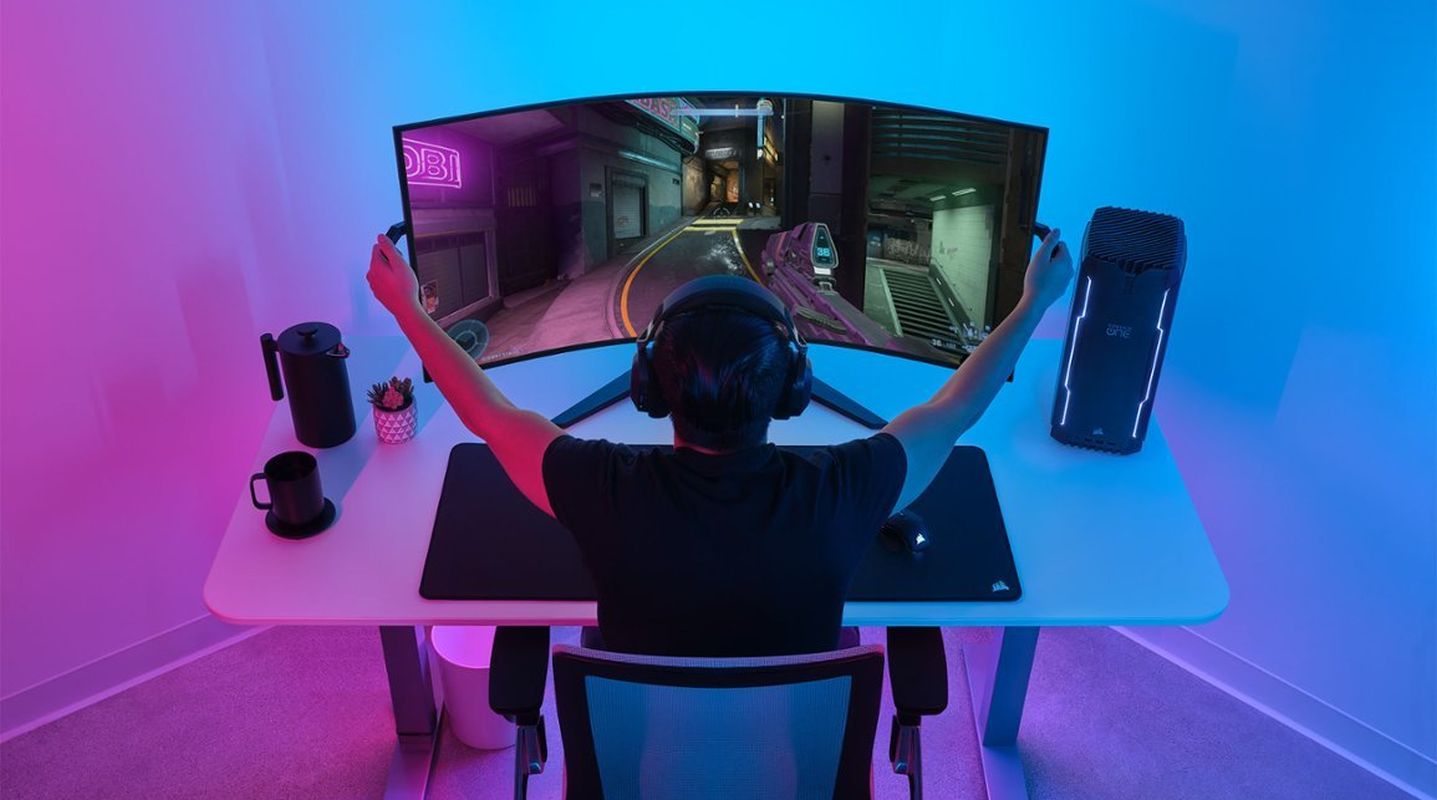
Pros
- Incredibly immersive gaming experience
- Huge 45-inch ultrawide OLED panel can be adjusted from flat to 800R curve to suit your setup
- Exceptional image quality, contrast, color performance, and HDR
- Elite motion clarity on a 240Hz panel
- Abundant connectivity with USB-C hub and power delivery options
- It made four people who walked into my office stop and say “WHOA” like Keanu Reeves
Cons
- Poor text clarity and general sharpness for productivity work
- Very expensive
- No swivel or tilt options, stand can’t be replaced
- Bending mechanism feels clunky and mildly terrifying at first
- Enabling HDR mutes desktop contrast and vibrancy
Want a monitor that can (literally) flex on your friend’s puny 34-inch ultrawide? The Corsair Xeneon Flex 45WQHD240 is for you.
The Xeneon Flex has a flexible OLED panel that can be positioned so that the display is entirely flat or curved up to a radius of 800R (among the most aggressive curves you’ll find on any monitor). A pair of handles on the right and left flank are used to flex the display. They feel a tad awkward but get the job done.
It’s a massive display with a 45-inch ultrawide panel and a 21:9 aspect ratio. It’s much, much larger than a 34-inch ultrawide (roughly 10 inches wider and 5 inches taller), which provides an extremely immersive experience and tons of room for multi-tasking apps. It’s also taller than a 49-inch super-ultrawide like the Samsung Odyssey Neo G9, though (of course) not quite as wide.
Image quality is excellent with an extremely high contrast ratio and wide color gamut. The 240Hz refresh rate provides superb motion clarity, too. Even HDR performs reasonably well, as the panel’s brightness is relatively high (for OLED, at least). The monitor’s 3440×1440 resolution doesn’t look sharp spread across the 45-inch panel, but this only feels noticeable on the Windows desktop. Games and streaming content look incredible.
The Corsair Xeneon Flex is built like a tank and has a massive, stable stand with built-in ports including USB-C. Unfortunately, the stand doesn’t adjust for height. It’s also an expensive monitor at a retail MSRP of nearly $2,000. That’s a lot of cash, but the Xeneon Flex’s versatile OLED panel and top-tier image quality justify the price.
What to look for in a monitor
There are literally hundreds—and perhaps thousands—of monitors to choose from. Choosing one from the crowd can be difficult, but knowing the key traits of a monitor will help you make your decision.
Resolution
Most monitors are available in 4K (3,840×2,160), 1440p (2,560×1,440) and 1080p (1,920×1,080) resolution. A higher resolution provides a sharper, more attractive image and is generally preferable. There’s nothing wrong with 1080p, however. It remains the baseline and is by far the most popular resolution sold today.
Connectivity
Look for a monitor with a connection supported by your computer. HDMI and DisplayPort are the most common. USB-C is rising in popularity because it can charge connected devices, such as a laptop.
Refresh rate
Most monitors have a 60Hz refresh rate, but a higher refresh rate (such as 144Hz) will make motion look smooth and crisp. This is most appealing to PC gamers, as improved motion performance is most noticeable when panning the camera in a 3D game.
Adaptive sync
This technology also improves motion performance. It does so by keeping a monitor’s refresh rate in sync with the video input from your computer. Our guide to FreeSync and G-Sync provides more detail.
Want to know more before you make a decision? Our monitor buying guide explains the nerdy details of monitor specifications.
How we test monitors
Our monitor guides are based on testing by freelance and staff contributors with decades of combined experience.
While we rely on our eyes for an initial impression, we thoroughly test each monitor with a SpyderXElite color calibration tool. This specialized hardware can objectively measure a monitor’s brightness, contrast, color gamut, color accuracy, luminance and color uniformity, gamma, and many other aspects of image quality.
Using this tool helps us detect strengths and weaknesses that don’t stand out at a glance and guarantees that a change in lighting conditions or monitor location won’t skew our impression.
FAQ
What size of monitor should I buy?
Monitor size depends on personal preference and location.
A 24-inch monitor is fine for a desk that is around 24 inches deep, or less. Its small size will still be sufficient because the monitor is closer to you.
Most people, however, will want to go with a 27-inch monitor. The added size will make the monitor easy to see. This also opens up a wider range of 4K monitor options, as 4K is very rare on a 24-inch monitor.
Larger monitors, such as a 32-inch widescreen or 34-inch ultrawide, are great for deep desks and people who want an immersive experience. Monitors this large can serve as a TV replacement in a small room.
Displays of even larger size, such as 42-inch or 48-inch HDTVs, are best for home theater setups or an unusually large office. You’ll want to sit four to six feet away from a display of this size.
What display input is best? (HDMI vs. DisplayPort vs. USB-C)
USB-C is the best display input for most people. It works by bundling DisplayPort into USB-C, so offers all the same features as DisplayPort. Yet it retains the features of USB-C including optional support for Power Delivery to charge external devices. This is why we recommend a USB-C monitor for most people.
DisplayPort is generally second-best. It supports higher resolutions and refresh rates than HDMI. This input is particularly common on desktop computers.
HDMI comes in third due to lower resolution and refresh rate support. This is improved by HDMI 2.1, but this feature remains hard to find and often adds to a monitor’s price.
All three of the options above handle 1080p at 60Hz, which is the most common resolution and refresh rate available today. It’s also important to buy a monitor that has an input compatible with your PC.
Are all monitors compatible with Windows and MacOS?
Modern monitors are compatible with all recent versions of Windows and MacOS. They’re plug-and-play, which means the monitor should display an image without the need to install driver software or mess with Windows or MacOS settings.
